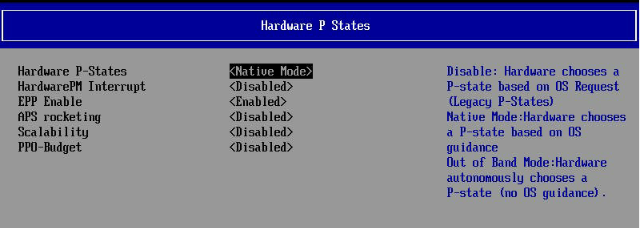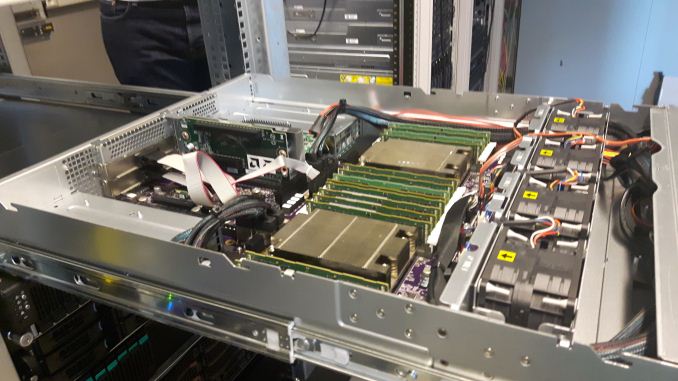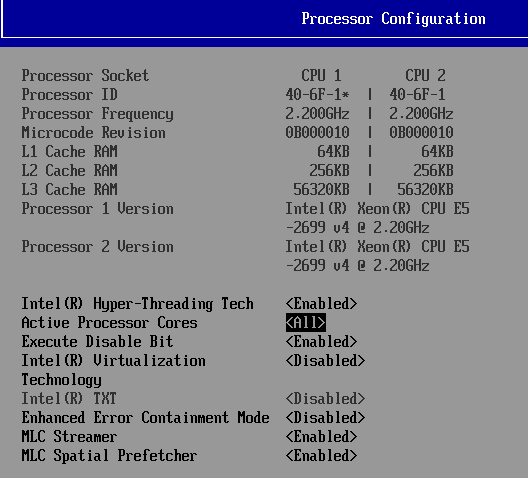Sizing Up Servers: Intel's Skylake-SP Xeon versus AMD's EPYC 7000 - The Server CPU Battle of the Decade?
by Johan De Gelas & Ian Cutress on July 11, 2017 12:15 PM EST- Posted in
- CPUs
- AMD
- Intel
- Xeon
- Enterprise
- Skylake
- Zen
- Naples
- Skylake-SP
- EPYC
Testing Notes
For the EPYC launch, AMD sent us their best SKU: the EPYC 7601. Meanwhile Intel gave us a choice between the top bin Xeon 8180 and the Xeon 8176. Considering that the latter had 165-173W TDP, similar to AMD's best EPYC, we felt that the Xeon 8176 was the best choice.
Unfortunately, our time testing the two platforms has been limited. In particular, we only received AMD's EPYC system last week, and the company did not put an embargo on the results. This means that we can release the data now, in time to compare it to the new Skylake-SP Xeons, however it also means that we've only had a handful of days to work with the platform before writing all of this up for today's embargo. We're confident in the data, but it means that we haven't had a chance to tease out the nuances of EPYC quite yet, and that will have to be something we get to in a future article.
Meanwhile we should note that we've had to retire the bulk of our historical benchmark data, as we upgraded both our compiler and OS (see below). Due to this, we only had a very limited amount of time to run additional systems, and for that reason we've opted include Intel's Xeon E5-2690. The Sandy Bridge-EP processor is about 5 years old, and for customers who aren't upgrading their servers every single generation, it's these servers that we believe are most likely to get upgraded in this round. So for server managers looking at finally buying into new hardware, you can get an idea of much return of investment you get.
Benchmark Configuration and Methodology
All of our testing was conducted on Ubuntu Server "Xenial" 16.04.2 LTS (Linux kernel 4.4.0 64 bit). The compiler that ships with this distribution is GCC 5.4.0.
You will notice that the DRAM capacity varies among our server configurations. The reason is that we had little time left before today's launch embargo. Removing any hardware is always a risk, so we decided to run our tests without significantly changing the internal hardware of the systems we received from AMD and Intel (SSDs were still replaced). As far as we know, all of our tests fit in 128 GB, so DRAM capacity should not have much influence on performance. But it wil have a impact on total energy consumption, which we will discuss.
Last but not least, we want to note how the performance graphs have been color-coded. Orange is AMD's EPYC, dark blue is Intel's best (Skylake-SP), and light blue is the previous generation Xeons (Xeon E5-v4) . Gray has been used for the soon-to-be-replaced Xeon v1.
Intel's Xeon "Purley" Server – S2P2SY3Q (2U Chassis)
| CPU | Two Intel Xeon Platinum 8176 (2.1 GHz, 28c, 38.5MB L3, 165W) |
| RAM | 384 GB (12x32 GB) Hynix DDR4-2666 |
| Internal Disks | SAMSUNG MZ7LM240 (bootdisk) Intel SSD3710 800 GB (data) |
| Motherboard | Intel S2600WF (Wolf Pass baseboard) |
| Chipset | Intel Wellsburg B0 |
| BIOS version | 9/02/2017 |
| PSU | 1100W PSU (80+ Platinum) |
The typical BIOS settings can be seen below; we enabled hyperthreading and Intel virtualization.
AMD EPYC 7601 – (2U Chassis)
Five years after our "Piledriver review", a new AMD server arrives in the Sizing Servers Lab.
| CPU | Two EPYC 7601 (2.2 GHz, 32c, 8x8MB L3, 180W) |
| RAM | 512 GB (16x32 GB) Samsung DDR4-2666 @2400 |
| Internal Disks | SAMSUNG MZ7LM240 (bootdisk) Intel SSD3710 800 GB (data) |
| Motherboard | AMD Speedway |
| BIOS version | To check. |
| PSU | 1100W PSU (80+ Platinum) |
Intel's Xeon E5 Server – S2600WT (2U Chassis)
| CPU | Two Intel Xeon processor E5-2699v4 (2.2 GHz, 22c, 55MB L3, 145W) Two Intel Xeon processor E5-2690v3 (2.3 GHz, 14c, 35MB L3, 120W) |
| RAM | 256 GB (16x16GB) Kingston DDR-2400 |
| Internal Disks | SAMSUNG MZ7LM240 (bootdisk) Intel SSD3700 800 GB (data) |
| Motherboard | Intel Server Board Wildcat Pass |
| BIOS version | 1/28/2016 |
| PSU | Delta Electronics 750W DPS-750XB A (80+ Platinum) |
The typical BIOS settings can be seen below.
HP-G8 (2U Chassis) - Xeon E5-2690
| CPU | Two Intel Xeon processor E5-2690 (2.9GHz, 8c, 20MB L3, 135W) |
| RAM | 512 GB (16x32GB) Samsung DDR-3 LR-DIMM 1866 MHz @ 1333 MHz |
| Internal Disks | SAMSUNG MZ7LM240 (bootdisk) Intel SSD3700 800 GB (data) |
| Motherboard | HP G8 |
| BIOS version | 9/23/2016 |
| PSU | HP 750W (Gold) |
Other Notes
Both servers are fed by a standard European 230V (16 Amps max.) power line. The room temperature is monitored and kept at 23°C by our Airwell CRACs.














219 Comments
View All Comments
tmbm50 - Wednesday, July 12, 2017 - link
Windows licensing is irrespective of virtualization.If you run a vm with a single vCPU on a server with 32 cores, you must license all 32 cores. KVM, ESXi...doesnt matter.
I'm sure most folks ignore that point in the license but if your an enterprise and get audited it's enforced.
nils_ - Wednesday, July 19, 2017 - link
Oracle does the same, and if your environment supports migration to other hosts you'd have to license those too (just in case). It's sort of criminal really.pepoluan - Friday, July 28, 2017 - link
I wonder, though, how does AWS managed to offer per-instance Windows licensing for EC2?Because, by that logic, EVERY Windows instance needs to be licensed against ALL cores in an Availability Zone...
Rοb - Sunday, July 23, 2017 - link
From very brief research it looks like for you're in for $6K per 16 Cores for the Datacenter Edition, trying to run the Software on a 4S 32 Core would cost 64x as much (excluding any Bulk Buy pricing you might be able to request).If you bought SM Fat Twins everything would be separated with less loss of density; for the money saved on Licensing would it pay off.
You want to conduct your business lawfully and can charge the customer what it costs plus profit - that's what it costs, want something different the price will probably be different.
Most Software that has per Core Licenses costs a fair bit and has thought it out so someone can't (lawfully) buy a single License and then run the Software on a much more powerful machine.
Take a deep breath and consider that if you ran it on a Phi x200 in x86 Mode that it would run slowly and you'd be charged for 256 Cores per CPU - so don't do that.
I don't want to sound unsympathetic but if the Vendor didn't make money then they wouldn't have incentive to write the Software.
Convince your customers to switch to free Software or for those prices write your own.
What is the complaint exactly, have a Rack Unit Fee, an Electricity Fee, a CPU Fee, a Software Fee, etc., and tell the customer that XYZ costs that much but if they get WYZ it will only cost so much instead.
Assuming everyone obeys the Law and pays the same for Electricity, Cooling, Electronics, Software and Labor then it's only the percentage of Profit where the difference in price lies - or in other words someone will always charge less (and not be 'audited' / as honest / as intelligent and hard working as your Team).
Let the people who you buy your Software from know your complaint and options, we can't be of much more help to you other than the years of service some of us devote to free and pay Software.
rocky12345 - Wednesday, July 12, 2017 - link
Great article as always I found it very well written and there was a lot of information to take in. It was good to see AMD chips doing this good. Bang for the buck seems to be in AMD's court in both the server market and consumer markets now.To those saying oh in the real world big companies would not be upgrading there software to the latest because of money that may be lost. You guys have a solid point there. BUT these tests are not being done in a real world company that depends on their servers to be up 100% of the time. These are just in house tests done to benchmark the new CPU's so yes the latest and greatest versions of the software can be & should be used. This shows exactly what the new CPU's can do when the software is updated to support the latest and greatest hardware. DO you actually think a huge company when buying new server clusters asks for software that is 5 -10 years olds I am fairly sure they do not. They want the most update to date software that is optimized for the new hardware they are spending big bucks on. They want it to be 100% stable and they also want the latest and greatest because of the fact that they probably will never update the software again or at least not for 5-7 years or more. So testing with old builds of software is very unrealistic and does not show the hardware at it's best and also not what a company is looking fro when buying new hardware.
With that said this is still a great write up and deserves a lot of praise.
rahvin - Wednesday, July 12, 2017 - link
I think it's a great comparison article too, you know it's pretty unbiased when both the Intel and AMD fanboi's are out in force criticizing the article for bias.My main comment is that Intel is crazy with those prices on the platinum chips. Those prices are easily two times the previous generation. This is the result of AMD being absent from the server market, that is Intel running processor prices up to the prices that Sun, IBM and HP used to charge in the worst of the enterprise server days. $13k for a Xeon, you've got to be shitting me.
Here's to hoping AMD mops the floor with them and causes prices to crater just like the last time Opteron was competitive. I remember the days when the highest end Xeon was less than $1000. These days the bottom end Xeons are pricing at $1000 and the high ends are 13X that much. Again, I pray AMD can get 25% market share and knock these prices back into reasonable territory. I also hope AMD makes a ton of money and can keep it up with competitive designs (even if it is doubtful because their management is garbage).
Rοb - Sunday, July 23, 2017 - link
Rahvin writes: "$13K for a Xeon ...".There's more to it than that, read the Fine Print; Intel has all kinds of expensive/inexpensive (depending upon your point of view).
See this Comparison: https://ark.intel.com/compare/120498,120499 .
Which is "less expensive":
Intel® Xeon® Platinum 8180M Processor (28 Cores) for $13,011.00
or
Intel® Xeon® Platinum 8156 Processor (4 Cores) for $7,007.00
So which is less 13 or 7 vs. 28 or 4?
You can't just look at one number.
There are other Technical Points, AMD doesn't have: AVX-512, OmniPath 400Gbps, 8-way Motherboards, etc.
If you MUST have what Intel offers then there's only one choice, if you can work around those things and get along with AMD then you're saving money.
If you wanted bleading edge performance then you'd be looking at Spark or Power; some complain that would deny the ability to play Crysis (and that due to their importance people stay up worrying about their issues).
Which is "best" is often easy to say given a narrow definition, which is best in every possible circumstance can be more of a challenge.
Disclaimer: I don't work at either place and intend to buy Epyc 7nm.
hahmed330 - Wednesday, July 12, 2017 - link
Jolly Good! AMD just smoked Intel's bacon!Impressive showing! Outstanding just outstanding!
Shankar1962 - Wednesday, July 12, 2017 - link
Yeah thats why AMD is still in losses and Intel is making net profits of ~$11billion plus each yearThey are gaining share by trying to sell their so called top products for cheap prices
Wondering who is getting smoked
PixyMisa - Thursday, July 13, 2017 - link
Epyc has been out for three weeks.